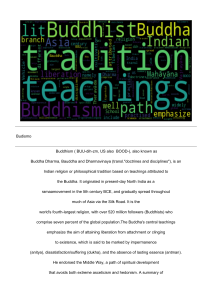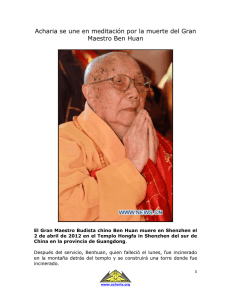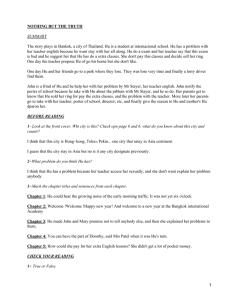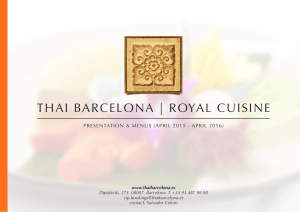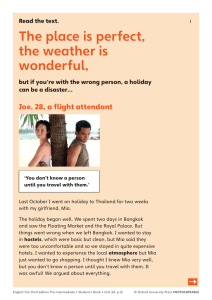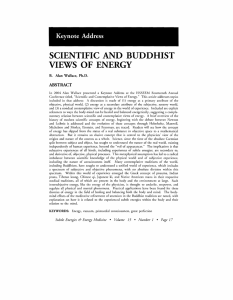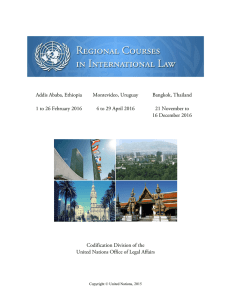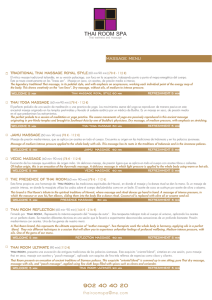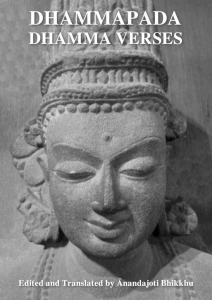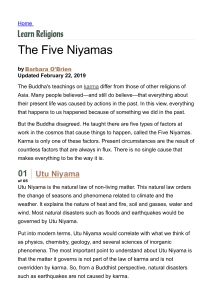Life History of Buddhadasa Bhikkhu Family, Childhood and Education
Anuncio
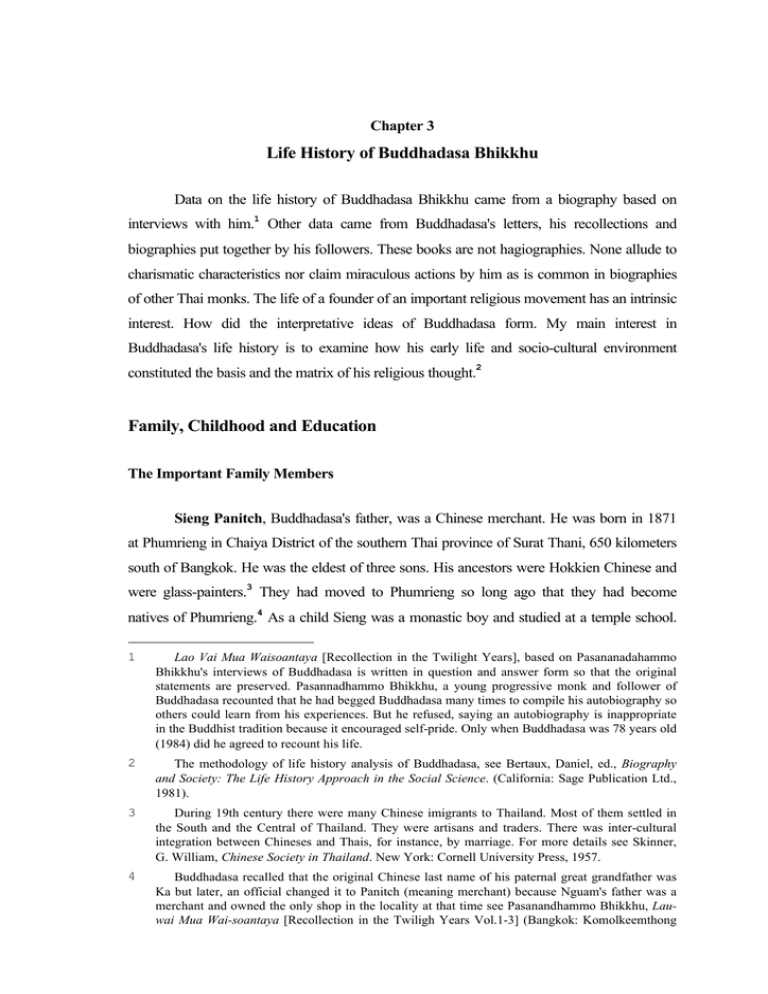
Chapter 3 Life History of Buddhadasa Bhikkhu Data on the life history of Buddhadasa Bhikkhu came from a biography based on interviews with him.1 Other data came from Buddhadasa's letters, his recollections and biographies put together by his followers. These books are not hagiographies. None allude to charismatic characteristics nor claim miraculous actions by him as is common in biographies of other Thai monks. The life of a founder of an important religious movement has an intrinsic interest. How did the interpretative ideas of Buddhadasa form. My main interest in Buddhadasa's life history is to examine how his early life and socio-cultural environment constituted the basis and the matrix of his religious thought.2 Family, Childhood and Education The Important Family Members Sieng Panitch, Buddhadasa's father, was a Chinese merchant. He was born in 1871 at Phumrieng in Chaiya District of the southern Thai province of Surat Thani, 650 kilometers south of Bangkok. He was the eldest of three sons. His ancestors were Hokkien Chinese and were glass-painters.3 They had moved to Phumrieng so long ago that they had become natives of Phumrieng.4 As a child Sieng was a monastic boy and studied at a temple school. 1 Lao Vai Mua Waisoantaya [Recollection in the Twilight Years], based on Pasananadahammo Bhikkhu's interviews of Buddhadasa is written in question and answer form so that the original statements are preserved. Pasannadhammo Bhikkhu, a young progressive monk and follower of Buddhadasa recounted that he had begged Buddhadasa many times to compile his autobiography so others could learn from his experiences. But he refused, saying an autobiography is inappropriate in the Buddhist tradition because it encouraged self-pride. Only when Buddhadasa was 78 years old (1984) did he agreed to recount his life. 2 The methodology of life history analysis of Buddhadasa, see Bertaux, Daniel, ed., Biography and Society: The Life History Approach in the Social Science. (California: Sage Publication Ltd., 1981). 3 During 19th century there were many Chinese imigrants to Thailand. Most of them settled in the South and the Central of Thailand. They were artisans and traders. There was inter-cultural integration between Chineses and Thais, for instance, by marriage. For more details see Skinner, G. William, Chinese Society in Thailand. New York: Cornell University Press, 1957. 4 Buddhadasa recalled that the original Chinese last name of his paternal great grandfather was Ka but later, an official changed it to Panitch (meaning merchant) because Nguam's father was a merchant and owned the only shop in the locality at that time see Pasanandhammo Bhikkhu, Lauwai Mua Wai-soantaya [Recollection in the Twiligh Years Vol.1-3] (Bangkok: Komolkeemthong 73 He was also once ordained as a Buddhist monk.5 He spoke very little Chinese. Sieng married a Thai official's daughter, Klaun Panitch. He owned his grocery shop at Phumrieng and maintained his interest in Buddhist teachings althrough he did not engage so much in rituals and merit-making. He did not take up drinking, smoking or gambling and did not believe in some local superstitions and therefore there was no spirit house in his own house. Sieng died quite early in 1923 when Buddhadasa was seventeen years old. Kluan Panitch, Buddhadasa's mother, was born in 1883 at Ta Chaang district nearby Phumrieng. Her grandparents were Thais and were farmers who had been living at Ta Chaang district for a long time. Her father was a district official of Ta Chaang. Klaun was one of the five children and was the only one who married a Chinese. There were many Chinese in the South and inter-marriage between Thais and Chinese was usual for people in that region at time.6 Kluan's ancestors were devoted Buddhists, meditating even at home. She had had an intimate familiarity with Buddhism since childhood and was a very devout Buddhist. When she married she moved to Phumrieng to live with her husband who was a grocer. She carried out the Buddhist religious rituals, went to merit-making every Buddhist sabbath day and received instructions. Klaun's religious beliefs seem to have made a profound impression on her growing children, she later played an important role in the proliferation of her own sons' work. She died in 1947 when Buddhadasa's movement began to develop. Yee-Guey Panitch, Buddhadasa's younger brother, is one of the most important family member who was a significant advocate in spreading Buddhism and founding Buddhadasa's movement. He was born in 1908. Like his father he was a monastic boy and studied at a temple school. After his secondary school, he studied pre-medicine at Chulalongkorn University in Bangkok from 1925 to 1926. During this time he was impressed Foundation, 1985), p. 4. 5 6 Sieng's father was Chinese and interested in Buddhism. He had many dhamma books of his own to read. His mother was Chinese-Thai and was earnest about merit-making. Interview with Dhammadasa in 1988, at Chaiya. 74 by articles he read from the University newspaper and the Japanese magazine "Young East" about the Buddhist revival taking place in other countries. Of special interest was Anagarika Dhammapala, the Singhalese man trying to revive the Buddhism in both Sri Lanka, India as well as the propagation of Buddhism in Western countries by Anagarika Dhammapala.7 In 1927, he returned to Phumrieng for a visit but stayed on instead of pursuing his medical studies. One reason was to enable his elder brother, Buddhadasa to continue his monkhood without any worries about business and family. He married a Thai farmer's daughter in 1932. They lived with his mother in Phumrieng. Yee-Guey was not ordained, but remained interested in religious problems. He translated and wrote articles on Buddhism for popular journals at that time, using the pen name of Dhammadasa. Finally, he changed his name to Dhammadasa (which means The Servant of Dhamma) in 1932. In 1933, he published a quarterly journal, Buddhasasana, in order to spead Buddhism and still continues publishing until today. After the death of his mother, he took over the family shop and left the responsibility of running the business to his wife. Most of his time was devoted to the work of the movement such as financial arrangements, publishing the journal and organizing activities of the movement in his community. At present he is still active in spreading Buddhism. Siang Panitch, Buddhadasa's younger uncle, was the other family member who influenced Buddhadasa. Siang was born in 1876. He was ordained at the age of 20 and studied at Wat Patumkrongkra in Bangkok for 10 years and could read the ancient Pali manuscripts.8 He was an adaptive and inquistive person, more interested in study and had better opportunities than Buddhadasa's father who had never been to Bangkok at all. He 7 Anagarika means one who enters the homeless life without formally entering the Sangha. Anagarika Dhammapala (1864-1933) was a leader of a Buddhist movement in Sri Lanka, which was founded at the end of the nineteenth century. This movement was not only in with the line revival Buddhism in Sri Lanka and India, but also propagated Buddhism in the West. Dhammapala set up the Maha Bodhi Society in 1891 and later (1892) began publishing the Maha Bodhi journal which soon became a powerful vehicle for the dissemination of Buddhism (Gokhale, Balkrishna Govind, "Anagarika Dharmapala" in Contributions to Asia Studies Vol. 4, Bardwell L. Smith, ed., 1973), pp. 30-33. 8 Because Siang resided at Wat Patumkongka, many monks from Phumrieng and Chiya including Buddhadasa studied there. 75 usually sent some magazines and letters relating to the happenings in Bangkok to his nephew (Buddhadasa). After disrobing, Siang married a Chinese-Thai merchant's daughter and moved to live with his wife at Chumporn, the southern province of Thailand. There, he was a clerk in a bird's nest factory. Siang played an important role in stimulating Buddhadasa to study Pali scripture at Bangkok in order to be able to read the original Pali Text. Siang often wrote letters to Buddhadasa relating to the point that he agreed with Buddhadasa's ideas of Buddhist interpretation. He died in 1951 when Buddhadasa's movement had spread to many regions of Thailand. Childhood and Education Buddhadasa (1906- ) was originally named Nguam Panitch. He was born on May 27, 1906 in a small merchant family at Phumrieng, a small town on the eastern coast of the southern Thai province of Surat Thani where his Chinese father and Thai mother owned a general shop.9 He is the eldest of three children of Sieng and Klaun Paitch. His younger brother is Yee-Guey or Dhammadasa (1908-), who later became a significant advocate of spreading Buddhism. The youngest sister of Nguam, Kim-Soy (1911-1989) married a Chinese merchant's son and moved to Ban Don, the central district of Surat Thani.10 There is no evidence that she had any important role in the proliferation of her brother's work. Nguam's father often travelled on business to buy goods for his shop which was the 9 Phumrieng, about 70 years ago, was a small town located on the eastern coast of southern Thai province of Surat Thani. People of Phumrieng mostly made their living from fishing and rice farming. Fishing was done at the domestic level, surpluses were traded and the standard of living for most residents was moderate. Those who were considered affluent were the ones who owned several rice fields. Even the affluent were not much different from poorer villagers. It was the officials who had much higher status. The relationship between people and the officials was hierarchical. The people felt they existed at different levels, but these levels were not in conflict. The people were earnest in merit-making. The religious influence on the people was profound; their lives and the monastery were inseparable (Pasannadhammo Bhikkhu: 1985, p. 40). 10 Dhammadasa recounted that his original name, Yee-Guey and his sister's name, Soy or Kim-Soy were not Chinese names but ancient Thai names. They were given by the senior monk in Phumrieng (Interview with Dhammadasa at Chaiya in 1988). 76 only one in Phumrieng at that time.11 His mother took responsibility for the shop as a shop-keeper. Nguam's early childhood (1906-1913) was thus spent with his mother. As the elderest son, he was expected to inherit, thus his youth was engaged in work on family's shop quite early. The mother was strict with her children, especially thriftiness and usually cautioning them to do their best at work.12 They were not allowed to fish or to kill every kind of animal even to sing popular songs because she believed that they were degrading. Nguam was trained in a line of Buddhism which affected his personality very deeply. However, his early childhood seems not to have differed much from other Thai children of that time.13 From 1914 to 1917 Nguam was sent to receive a basic education at Wat Mai, a temple boarding school providing a new independence and pleasant environment for Thai boys. In traditional Thai society, temples were the core of the Thai educational system for many centuries. Most of Thai boys were sent to study at the temple for two or three years. There, they learned how to read, to write and studied religious traditions as well as Thai culture. They gained more skill and experience in how Thai boys adjusted themselves to the outside world beyond their families. As a boy, Nguam learned how to read, to write and was trained in living with others; he learned group restrictions and responsibilities. Such opportunities and training traditionally could be found only in temples. It was traditional in Thai society for a Thai boy to stay in a temple. The educated monks would take care of them by providing them with food and lodging, teaching them eating discipline, giving them an education, and training them in religious tradition and some other activities such as serving a monk, cleaning the temple, fetching water, gardening, making bamboo utensils, etc. Rice was obtained from monks' going on alms rounds and 11 For a study of business practises among Chinese imigrant in rural areas see Auansakul, Punnee The Development of the Domestic Rice Trade in Central Region Thailand 1800-1938. (unpublished Ph.D. thesis, Bielefeld University, 1990). 12 Buddhadasa said that if asked how his mother influenced him, he would immediately answer that it was the thriftiness not only vis a vis expenses, but also with water and firewood. All things were to be used just enought for need and never wasted. Everything was to be done thriftily as possible, even the use of time. Somethings were saved unnecessarily, but she did so only to show that they could be saved. His father, a Chinese merchant, was, on the other hand, rather easy-going on this point (Pasannadhammo Bhikkhu: 1985, p.7). 13 Interview with Dhammadasa at Chaiya in 1988. 77 condiments from households which provided daily supplies. The boys learned how to read and write in the morning and afternoon. Thai boxing, a means of self-defense, was taught in the evenings. After evening chanting, activities are arranged to train the children to be clever, witty, logical, wary, and observant. Both the novices and the temple boys gathered together to discuss such topics as cooking rice. A volunteer would describe how to do it, while others listened and objected when he made a mistake. They enjoyed this very much. If too many objections arose, others would take over. The discussion went on until it was described so perfectly that nobody could make any objections. The parents were gratified that their children get in to a temple because the children could work at gardening, make bamboo utensils, prepare herbal medicines, and so on. If the parents did not need the children to help them at home, the children continued living in the temple until they were ordained as novices and monks. Each local temple would have about twenty to thirty monks (for instance, there were five temples in Phumrieng). After ordination, they traditionally stayed at the temple about three or four years for studied Buddhist Texts, Thai literatures, and leading the traditional rituals, after which they disrobed and came out to start families.14 14 Pasanandhammo Bhikkhu: 1985, pp. 38-41. The Thais, like other Theravada Buddhist people in Southeast Asia, adopted the ideal that every male should spend a period of time as a member of Buddhist order. This ideal was realized by a boy becoming a novice and a man, at age twenty was ordained as monk. When a man entered the monkhood in Thai Buddhism, he did not, as in Catholicism, necessarity commit himself to remain in the religious order for life. Most of them return to lay life but only some of them remained permanently in Buddhist Sangha. By this tradition, a degree of literacy obtained among males in Thai society was high. In 78 seventeenth century, visitors from France to Ayutthaya (an old capital of Thailand between 1467-1867) were impressed by the greater degree of literacy in Thailand than in France of that time, see Keyes, Charles F. Thailand. (Colorado: Westview Press, 1986), p. 36. 79 In 1918, at age twelve, Nguam went to a formal elementary school at Wat Nau and at the end of 1921 he transfered to study at Sarapi Uthit school in Chaiya, six kilometers away from Phumrieng. Both schools introduced a new form of Western educational system. Nguam received formal education from these two. He had moderate success in his studies but did not enjoy them, due to the fact that the schools demanded full time study and so many regulations. However, during that time (1921-1923) Nguam stayed with his father who had opened another shop in Chaiya because the new main transportation route ran through this town. As the transportation improved the trading activities and networks in Chaiya developed and it became a central district of Surat Thani at that time. Nguam was close to his father, he helped him in the business and learned from him. His father's habit of spending leisure time writing poetry impressed Nguam immensely. Later, he too, wrote poems.15 The new environment of Chaiya, quite different from that of Phumrieng, later inspired him to study and to write the history of archaeology of this town. Chaiya has many temples, with relics dating from the time of the Sri Vijaya Kingdom in the eighth century A.D. Religious tenets maintains itself among the ordinary people. It were ingrained through folk tales and children's lullabies known throughout southern Thailand. Historically, Chaiya was also a renowned center for Buddhist study. In 1923, when Nguam was seventeen, his father died. He had to leave school during his senior year. The shop in Chaiya was closed and he moved to Phumrieng. Thus Nguam took over responsibility as head of the family when he was only 17 years old. His time was spent wholly in business and housework. He never had a chance to take any pleasure trips except when visiting his mother's relatives at Ta Chaang two or three times a year. However, since the shop was the only one in Phumrieng which was a place where people regularly met, talked and exchanged the wide ranging information both inside and outside of the community. Through this business Nguam met many people. He had a good relationship with other residents, namely, farmers, fishmen and the officials who were well educated, exchanging ideas informations and conversation. This led him to develop the habit of discussing and 15 Buddhadasa is famous for being competent in expressing the dhamma poetically and profoundly. His former ecclesiastical title, "Rajja Jaya Kavi", means a genius in poetry (Interview with Panyananda Bhikkhu, a close friend of Buddhadasa, at Wat Chonprathan in 1988). 80 expressing ideas independently. At the beginning of the twentieth century the impact of King Rama V's Reforms were being felt in various parts of the country. The reforms included an introduction of formal education, expansion of capitalism, enlargement of transportation, utilization of modern technology and freedom in expressing ideas about the government system. This led to conflicts of different political and social ideologies which were expressed through the expansion of mass media in the reign of King Rama VI. Moreover, there was a propagation of modern nationalism for which King Rama VI was the pacemaker. He played a major part in rousing the Thai people to think of national goals through poetry, dramas, articles, etc. Many of the King's articles influenced the Thai people's thoughts profoundly. "The Jew of the East", an article he published in 1914, compared the Jew to the Chinese. It caused apprehension and distrust between the Thai and the Chinese, the latter having had problems with previous Thai governments. Changes took place in Phumrieng through influences from the capital, Bangkok. By 1910, Phumrieng had been the site of the District headquarters. The government officials and their families came from Bangkok and lived in Phumrieng. This resulted in the local people's being culturally influenced more rapidly than other districts. The harmony of Phumrieng was gradually altered. Islam also expanded through Surat Thani by migration and became stronger. Nguam knew about the developments that took place in the country. He received letters and magazines from his uncle Siang, a monk in Bangkok. He read the books of progressive and socially critical Thai intellectual writers of that time, such as Tienwaan and K.R.S Kurab. Due to the fact that the shop also sold books, he had the opportunity to do a lot of reading. He read all kinds of books available in the shop such as children's books, humor books, traditional dhamma books and Western historical and novels. Early Interest in Buddhism How did Nguam first become interested in Buddhism? His original interest was arroused by his mother, who was an earnest believer of Buddhism. There were usually both 81 monks and the mother's friends visited the shop to talk and discuss religious topics, particularly the existence of heaven and hell, the effects of doing good and evil and observing the precepts. At these discussions Nguam was reported to gradually began to wonder why, if all such things were unreal, so many people had adhered to them for thousands of years.16 At that time (1925) the Buddhist circle in Phumrieng was highly intrigued by the newly introduced educational curriculum for the clergy.17 It was a result of King Chulalongkorn's Reform of Sangha educational system. A number of monks and novices from Phumrieng and nearby districts enrolled for study. The family shop was transformed into a forum for dhamma discussions by five or six interested lay people. Nguam was attracted by the discussions as they were a new topic. He bought and studied the official dhamma books for the three-year curriculum, together with an Abhidhamma, a highly venerated literature of orthodox Buddhism.18 He then understood the dhamma better and began eagerly participating in the discussions. He reserched and gathered things in order to talk and debate. He was the only young person in the group at age of nineteen, but was soon accepted as the group's teacher because of his clearer explanations with specific references to his readings. It was a new thing, different than these they had heard before. The interest of this group grew and they came around and talked more frequently. The discussions were mainly on the meaning of the Buddha, the Dhamma, the Sangha, merit-making, and most popular of all, traditional beliefs in life after death, heaven and hell. Nguam disagreed with all these beliefs. Undoubtedly, he was particularly influenced by his readings of the official curriculum dhamma books of Vajirayana. Apparently, he was exposed 16 17 18 Chit Pibanlthan, Chivit lae Ngan khong Buddhadasa [Life and Work of Buddhadasa Bhikku], (Bangkok: Kasembanakij, 1971), p.15. More details see Chapter 2. These text books were composed of Nawakowat (meaning the teaching for the newly ordained monks), which comprised three sections: Vinaya Banyat, a translation into Thai of the 227 precepts of monks; Thammawiphak, an arrangement of Thai translations of important passages of the Tipitaka which present the basic doctrines in enumerative catagories; Khihipatibat, an exposition of the right way of the monks to live. Phutthasatsanasuphasit vol.1-3 (Selected Buddhist proverbs), is, in effect, an amplification of Thammawiphak, containing a selection of important passages from the original Pali Texts with a Thai translation alongside the Text. Phutthaprawat vol.1-3 (The life 82 to the new trends of Buddhist teachings from an early age. During 1924 to 1926 Nguam was involved in commerce and in discussing the dhamma. As his business improved, the consideration and the value he placed on religion also increased. His good basic education from six classes of the school, business experience, skills in free expression of opinion and debate, and the local atmosphere of Buddhist study at that time, constituted the breeding ground for his critical interest in questions, and in his search for answers. Although his background was business oriented he engaged in Buddhism before entered the monk at age of twenty. It may well be said that Nguam's path to monkhood had been pre-ordained. Early Life as Buddhist Monk Like other Thai men, upon reaching the age of 20, Nguam wanted to enter the monkhood. He intended to be a monk for only one pansa (Buddhist Lent), covering three months and then return to his business. He was ordained on July 29, 1926 into the Mahanikaya Order at Wat Nok. Afterwards, however, he went to stay at Wat Mai.19 He was given the monastic name of "Indapanno", meaning one who has wisdom like Indra.20 Henceforth I will refer to Nguam as Indapanno to stress the change of his life from a layman to a monk. The new life as a monk proved not to be a burden, everything settled down after a few days. The peaceful atmosphere of the monastery, the restraint placed on his actions, speech and thoughts enabled him to be more peacefully mindful. He also enrolled at Nak tham school (Dhamma Study school) in Wat Nua.21 of Buddha), Vinayamuk vol.1-3 (The entrance to the Vinaya). For more details see (Ishii: 1986). 19 20 21 Nguam was ordained at one temple but stayed at another because he had lived in Wat Mai when he was a child. His maternal granduncle had been the abbot of this temple and died there. His father had also ordained in this temple. One reason his ordination ceremony took place at Wat Nok was because his parents and the abbot were well acquainted with one another (Pasannadhammo Bhikkhu: 1985, pp. 41-42). Indra is one of the Hindu Gods. Nak tham school had been introduced to teach a basic standard of doctrinal studies for the newly ordained mohks and novices. The nak tham curriculum consist of three levels: elementary level (nak tham tri), intermediate level (nak tham tho), and advanced level (nak tham ek). The curriculum covered essential points of the doctrines so that one could understand these points 83 After having been ordained for only two days, the abbot encouraged him to preach, saying that Indapanno had a reputation of knowing dhamma well even when he was still a lay person. People found his preaching worthwhile listening to because they have never heard it before. Word spread and people flocked to come to listen. As the people enjoyed his sermons, the abbot asked him to preach everyday. The number of people attending his sermons increased remarkably because his preaching was new both in style and content. Traditional preaching simply involved reading ancient texts. Indapanno chose the dhamma topics he learned from Nak tham school, explained them in simple terms and supplemented them with parables from the Jataka (legend). As his popularity increased people from other temples came to attend his sermons. Other temples had to arrange their preaching schedules to accommodate Indapanno's sermons. Especially on observance days he preached in different temples at different times: first at one temple, then to a second and finally at his own, some people listened to all three sermons.22 He became a famous preacher in Phumrieng with an average of 30-40 people attending his sermons. On certain days the sermon hall would be overflowing. Many young people started attending, which pleased the abbot. Indapanno devoted his time mostly in studying, reading and drafting the sermons. His curiousity led him to study dhamma from every book available in the locality at that time, including the Buddhist journal of Dhamma Caksu (Eye of the Dhamma) which was issued under the authority of Wachirayan (Vajiranana).23 In this journal, there were translations of various sutta from the Tipitaka, in a style independent of the senior monks of that time. easily. Success in the three levels of doctrinal exams was made an essential qualification for candidacy for the traditional Pali studies. The majority of monks who remained for any length of time in the robe came to aspire at least to pass these exams. It was virtually the only incentive for studying the dhamma (Ishii: 1986, p.76). 22 During the Buddhist Lent, every temple arranged preaching each evening; after the Lent preaching occurred only on holy days and festival days (Pasannadhammo Bhikkhu: 1985, p. 48). 23 Dhamma Caku was a Buddhist magazine published for intellectuals and writers who were interested in Buddhism. Buddhadasa recalled that the monks who were remarkable in writing and translation at that time were mainly Thammayut monks because they were educated and were supported by noblemen while the Mahanikaya monks were still lagging behind in that aspect (Pasannadhammo Bhikkhu: 1985, p. 52). 84 Indapanno was immersed in various activities and had also written a two-page newspaper to be distributed inside the temple everyday. This newspaper had articles, jokes, cartoons and caricatures which he handed out to the other monks after the evening chanting.24 Certainly, it improved his writing anis a way of spreading his ideas as well. He issued the newspaper for two years. As we shall see Indapanno's intention in studying was not only to amass knowledge for its own sake but to spread it to others from the beginning. He enjoyed preaching, studying and performed well in his monastic exams. He had a good relationship with the abbot and his comrade monks. He forgot about his first intention to be a monk only for three months. He enjoyed the monastic life very much and did not have to worry about the shop because his younger brother, Yee-Guey, had left school and taken responsibility for the family shop. Pali Study in Bangkok Indapanno continued his studies through a second pansa (Buddhist Lent) and passed the intermediate level of Nak tham (Nak tham tho). Then, his uncle Siang from Chumporn, who had been a monk in Bangkok for many years, took the trouble to push him up to Bangkok, where he could advance in his scriptural studies. His mother and brother also agreed that he should remain a monk. It was well known that if one wanted to make progress in the monkhood, one had to further one's scriptural studies in Bangkok.25 In 1928, Indapanno went to study the Pali scriptures in Bangkok and stayed at Wat Pathumkhongka. 24 After Indapanno handed out the newspaper to other monks, he would shut himself in his own room, listening to their laughter, criticising or mis- understanding. He found this very enjoyable. (Pasannadhammo Bhikkhu: 1985, p.50). 25 The traditional Pali studies begin with the third grades to the ninth grades (Prayok 3-Prayok 9), grade 1 and 2 were recognized not as independent grades but as preliminary stages to grade 3; only when a candidate had passed all three grades did he earn the appellation of Parian. He would also be addressed with the honorfic "Maha" before his name. The Pali studies focused on the translation syllabi from Pali to Thai and Thai to Pali. The latter, though termed "translation," actually involves the literal reproduction of the Pali texts; free translation is not acceptable. The Pali studies are classified by the division of the Tipitaka to which they pertain: the Sutta Pitaka for grades 3 to 6, the Vinaya Pitaka for grades 6 to 8, and Abhidhamma Pitaka for grades 8 to 9. What is characteristic is that none of the texts belong to the Pali Tipitaka; all are extracanonical commentaries. The students have no opportunity to address themselves to the original scriptures; they are required only to memorize and reproduce faithfully the orthodox commentaries (Ishii: 1986, pp. 94-95). 85 As Bangkok was the center of Pali studies, Indapanno was under the impression that monks in Bangkok did their best and lived correctly by the dhamma-vinaya (monastic discipline). They were to him the perfect role-model for monks because of their complete knowledge of the Scripture. Pali scholars with the ninth grade, he thought, were arahants (those who had attained Nibbana) and Bangkok was full of them.26 Indapanno's idealized view of monastic life in Bangkok was quickly shattered. The environment of noisy traffic, heat, dust, and crowded canals made him home-sick and he wanted to return home.27 Everything in Bangkok seemed the opposite of what he had imagined.28 Most of the monks simply studied for a degree and then disrobed to take a job and start a family. All of this was a severe shock to Indapanno's feelings and disappointed him. There was nothing in Bangkok that he was looking for. It was time to stop and try somethings else. He lost enthusiasm for his studies and instantly decided to return home to disrobe after having stayed in Bangkok for only two months. After returning home, his life became peaceful again and it was very close to the beginning of the Buddhist Lent. Indapanno decided to stay through his third Buddhist Lent at the former temple and studied the advanced level of Nak tham (Nak tham ek) by himself. He had become bored with school and teachers and did not believe that his teachers were truly knowledgeable. He passed his examination well. At the beginning of 1929, a Nak tham school was established at Wat Bhotaram, a royal temple at Chaiya. Indapanno was asked to be a teacher there for one year. This provided him with a good opportunity. No doubt, Indapanno had much freedom in selecting the teaching methodology in the two classes he taught. He 26 Pasannadhammo Bhikkhu: 1985, p. 83. 27 Buddhadasa recalled that Bangkok's environment and the temple in which he was staying was not only hot, dusty and noisy but also the garbage and polluted water in almost every canal emitted foul smells. The canal water was unusable when the tide was high and polluted water fused with the water in the utility well. Many noisy, smelly pigs also lived under his kuti (monk residence) (Pasannadhammo Bhikkhu: 1985, p. 84). 28 Buddhadasa recounted that Pali scholar-monks did not make any difference; their behavior was more heretical than the less educated rural novices and monks who still more strictly followed the monastic disciplines. For example, monks in Bangkok were not mindful of their eating etiquette; they chatted and laughed all the time like drunkards; they cracked open eggs and fried them. They did all these in spite of knowing that what they did violated monastic discipline (Pasannadhammo Bhikkhu: 1985, p. 52). 86 enjoyed it much partly because it was a new experience. All of his students in both classes successfully passed their exams. He instantly became a famous young teacher and received a typewriter as a reward. Back to Bangkok Again After a year of teaching, his uncle Siang again persuaded him to return to study Pali in Bangkok. Indapanno went back to Bangkok again in 1930. He stayed at the same temple in the same environment he already had experienced; but, this time he was wiser and lived in the capital in a different state of mind than before. Why did Indapanno go back to Bangkok without any hesitation? As far as I can determine, the one year as a teacher enabled him to develop a foundation for comprehension of Buddhist doctrine before moving on to the interpretation level of expressing critical ideas independently. While he was trying to explain the basic dhamma to his students, he realized its profound value and significance for his own life as well. He also did not think of disrobing and intended to learn Pali first, since it was the key to further studies in Buddhism from the original Pali texts. However, after he had attended the class for a few days, he could not put up with its sluggish pace. He was permitted to be absent. He studied the third level of Pali partly by himself, and partly by private tutorial with a monk from Phumrieng.29 Apart from this, he was interested in other branches of knowledge such as natural science, photography, typewriter repair, and also began to study English by himself. Particularly, he kept up with current events of the country and was much impressed by the writing of progessive leading Thai intellectuals, who returned from studying in Europe, namely, Chaopraya Thammasak Montri and Praya Anumanrajadon especially, what they wrote about science, world history and dhamma.30 In this year (1930), Indapanno wrote his first two articles. The first was a long article entitled "The Worldlings Level of Buddhism" published on the occasion of the opening of a Nak tham school at Chaiya. It was rather daring for the clergy of that time. Its content gave a critical look at Buddhism, explaining the benefits 29 Pali study began with the third level to the ninth level. 30 Pasanadhammo Bhikkhu: 1985, p. 113. 87 and advantages of Buddhism in contemporary meanings. Indapanno commented on attaining Nibbanna as the ultimate goal of Buddhism in the present, not as some distant ideal. This was quite innovative, for most Thai Buddhists, both monks and laymen, believed firmly that the attainment of Nibbana was virtually impossible in the present life. His second article was entitled "The Benefits of Giving" written for distribution at the funeral of his preceptor (the monk who ordained him). In it, he answered questions for the new generation who had begun to suspect the benefits of making merit. He also tried to lay the foundation of understanding Buddhism and presented new concepts appropriate for the people of that time such as that spritual benefit of giving was the decrease in selfishness. Both articles clearly illustrated that Indapanno had a strong committment to the ideals of Buddhism and their interpretation for a modern audience. He resolutely attempted to participate in maintaining the tradition in taking responsibility for its problems and deterioration. However, both articles have some traces of influence of the traditional concepts such as the belief in the next life. After passing his third level Pali examination, Indapanno became a Pali scholar-monk (Pha Maha Parien) as he had wished. In the following year, he studied at a higher level but his determination wavered because he had ambiguous feelings about its value. He was dissatified partly with the clerical education of that time since Pali study did not focus on the Tipitaka but on the commentaries. Whereas he wanted to translate Pali into simple Thai so that readers could comprehend, the ecclesiastical Pali curriculum required the students to translate the texts following a prescribed style. Consequently, his translation of the assigned Pali texts differed from his teacher's, as was clear on the pre-examination.31 This was to be expected as he had not attended the class since the beginning. Accumulation of knowledge, comprehension and critical views, together with reading more of the works of the leading Thai intellectuals, both monks and laymen, made Indapanno's interest in Buddhism extend beyond the scope of his formal studies and 31 The translation of Buddhst doctrine in the curriculum is the word-by-word Pali-Thai translation to maintain all the words and style in the source language. Thus, people in general do not understand it (Pasannadhammo Bhikkhu: 1985, 118). 88 examinations. He studied and learned in an independent manner. These factors drove him to deviate from his original intention of continuing with formal Pali studies. Criticism of the Thai Sangha During the time Indapanno was in Bangkok (1930-1932) he was influenced by several significant events. The Thai Sangha came under severe outside criticism regarding the conduct and way of life of the monks which were not in line with the dhamma- vinaya. The government at that time tended to give an opportunity for free criticism. Many lay people joined in groups to revive Buddhism in various ways. One group, led by Narin Phasit, critisized the Thai Sangha most strongly and declared themselves as revivers of Buddhism in its 25th century. The main point under attack was the excessively luxurious life style of the monks. Narin published books that attacked the Buddhist establishment and showed pictures of heretical behavior of monks in Bangkok, including the senior monks. He also established a temple for women and ordained his two daughters as female novices so as to revive the Buddhist tradition of having four constituent groups: Bhikkhu (male monk), Bhikkhuni (femal monk), lay man, lay woman. It was Narin's wish to promote Buddhism which he considered to have decayed because the Sangha no longer had the full complement of both male and female monks as at Buddha's time. The official Order of Theravada Bhikkhuni had fallen into decay before Thailand officially became Buddhist over seven hundred year ago. Narin's group was active for about three to four years and then he lost support because of the way he had gone about his vehement attack against the sanctity of the Sangha. Therefore, the majority of Thai people began to disagree with them. Indapanno was influenced by this criticism and had an opportunity to look critically at the problems and the reality of those days, as well as future solutions. The problems of the degeneration of the Sangha occupied Indapanno more and more. However, even though Indapanno objected strongly to monastic excesses and impropriety, he did not participate in the activities of Narin's group because he saw that what Narin did, was not the way to reform 89 Buddhism. He felt that attempts to reform the Sangha were impossible through external criticism. Instead, he believed the Sangha itself should return to its original tenets as found in the Pali Canon.32 However, many of his monastic friends, including his Pali tutor, did not agree with him. They believed that it was impossible to return to the original way of life as indicated by the Pali Canon since the world had greatly changed. It was likely that his ideas about Buddhism and the direction of his own life crystallized during the three years Indapanno spent in Bangkok in the early 1930s. There is evidence that while Indapanno was staying in Bangkok, he and his brother not only exchanged information and ideas through letters, mostly relating to the situation of the Thai Sangha in Bangkok including Narin's activities, but also co-operated in spreading their ideas. 33 From Indapanno's letters, it is clear that he charted their work according to the following plan: first, they had to acquire a complete set of the Tipitaka so that he could work with the original sources; second, they had to study the tenets of Buddhism from a variety of interpretative perspectives; finally, they should search for a practical method of practice consistent with the basic teachings in the Tipitaka. To carry out the last point, they agreed to find a site to facilitate dhamma practice by dedicated monks, hoping that this would promote Buddhism in what was assumed to be the last half of its life (2500 years). There was no place as appropriate as Phumrieng. As for the first two points, he had already started collecting as many volumes of the Tipitaka as possible and studied them by himself without depending on standard interpretations of the others.34 The more widely and deeply he studied the original Pali Text, the more his confidence grew in the highest ideal of Buddha's teaching. Indapanno, at that time (1932), was not interested in studying for an examination at all. Bangkok and Despair 32 Ibid., pp. 121-122. 33 Chit: 1971, pp. 35-39. 34 Ibid., p. 40-41. 90 The outcome of Indapanno's level-four Pali examination was that he failed it, as expected. He then completely gave up his original intention of taking examinations to become a higher level Pali scholar. He prepared to return to Phumrieng in a state of some despair about his own monastic career, as well as the state of Thai society and Thai Buddhism. He noted that "there was nothing satisfying or worth doing in Bangkok, because there were too many constraints".35 He thought of going away from Bangkok and doing something more substantial in the countryside; but exactly what he would do was still uncertain. Indapanno was confident that living according to the dictates of the Pali Canon and following the dhamma-vinaya was correct. He also wanted to recover the forms of early Buddhist practice, despite the fact that he himself did not really know much about them. Indapanno did not doubt that his Pali knowledge was sufficient to work with the Tipitaka. Furthermore, he was convinced that the study of Buddhist doctrine relied not only on a knowledge of Pali but also on contemplation and reason. The following is a quote from a letter by Indapanno to his younger brother, Yeeguey, before leaving Bangkok which illustrates his intention at that time. "... I cannot tell the exact date of my coming back home, but I have definitely changed my view from what I once held. This is because I fortunately found some good scriptures that helped me decide resolutely to leave Bangkok. I intend to find a retreat far from external and internal disturbances so that I can scrutinize the dhamma subjects that I have learned and hope to interpret. When I have finished my study, and attained a sufficient grasp of the principles of dhamma to make sure that my research will not go astray, I will abandon the textbooks then lead an unencumbered life and search for purity and truth. I am looking for a retreat where I can temporarily stay and work with my textbooks. I am totally blind about where, if it is not our home village. Everyone should think of me as if I were not staying in Phumrieng at all. I need someone who will help enhance my chances for study. For boarding, please make little change from before. If nothing is available, cooked rice offered mixed with a dash of fish sauce will be all right. Bangkok is not the place to find purity. The mistake I made in enrolling in the ecclesiastical study is a blessing, for it makes me aware that I made a wrong step. Had I not know this, I would have made many more, and, as some people have learned, it would have been difficult to retreat. With the awareness that I made a mistake I can discover how to step forward correctly....I have followed the world from the minute I was born to this moment. From now on: I will seek 35 Ibid., p.138 91 purity and follow the path of the Buddha which he had finally discovered. If I still stubbornly follow the world, I will lag far behind and will never enter the path. While I depend on the world physically, I will try my best to become detached from it spiritually so that I can find purity in the present....36 From this letter, it is obvious what Indapanno intended to do when he returned home. He convincingly emphasized that the pursuit of degrees in high-level monastic education in Bangkok was wrong. He not only criticized Thai Buddhist institutional schools but also disagreed with temple practice and the Sangha institute. He neglected his formal studies in Bangkok which he saw as irrelevant to the crucial problems facing Buddhism.37 The crisis of religion had challenged him to go "back to the source" to the original teachings and sought for the revival of Buddhism. Indapanno realized well the failures of a variety of lay groups in Thailand which had tried to reform the Sangha, such as Narin's group. Revitalizing Buddhism or even reforming the Thai Sangha was not easy. However, Indapanno chose to return to Phumrieng to begin following his ideas. This move has been seen as the decisive event in the foundation of his reform movement. Later he said: "In returning to Phumrieng at that time, I did not have any clear plans, but it was the only choice left. Having turned towards Buddhism, I had to go all the way. I was born in a merchant family which had almost nothing to do with religion. Discarding the family tradition, I was left only with the desire of wanting to do better than what others had been doing. Thus, I was diligent in self-training which was actually unorthodox for a merchant".38 Life at Suan Mokkh Period of Isolation When he returned to Phumrieng in 1932 at the age of 26, the dhamma study group (Dhammadana Group) led by his younger brother, Yee-Guey looked for a place for his seclusion and independence. A deserted temple named "Wat Traphang Chik" near Phumrieng which had been abandoned for over 80 years and which was in a dense jungle of 28 acres, 36 Chit: 1971, p. 35-39 (translation by author). 37 For more detail discussion in Chapter 2. 38 Chit: 1971, p. 140. 92 was Indapanno's dwelling. A small hut was built for him as he wished.39 He moved there in May, 1932, and named the place "Suan Mokkhabalarama" or "Suan Mokkh", meaning the Garden of Liberation. Calling a temple "Suan" (garden) is not common in Thailand. "Wat" is a traditional word designating a place containing the more conspicuous and elaborately decorated public buildings, namely, the vihara or the preaching hall, the sala (pavilions) where services are held, and sermons addressed to lay people, the bot (chapel) is used both for those activities relating to disciplinary affairs, which are the exclusive concern of the Sangha, and for other ceremonies such as ordination ceremony. The typical Wat has been traditional for a thousand of years. The word "Suan", however, denotes a natural environment where monks who search for liberation live in solitude under the shade of trees. Suan Mokkh represents, to the degree that it is possible, an original Buddhism designed with a sensitivity to the modern context.40 In June, 1932 (a month after Buddhadasa set up Suan Mokkh) Thailand changed from an absolute monarchy to monarchical democracy. Thus, Suan Mokkh was started in the same year as this government reform. Suan Mokkh came into existence when Indapanno became a forest monk.41 39 Indapanno's dwelling was a small hut one and a half meters wide and two meters long. The walls and the roof were thatched. Twenty-eight acres of dense jungle surrounded his residence. See Buddhadasa Bhikkhu, Seebpee Nai Suan Mokkh [Ten Years in Suan Mokkh], (Bangkok: Kongtuun Vudhitham, 1984), pp. 5-8. 40 Although, there were some Wat called "Suan", for instance, Wat Suan Dok in Chiang Mai. But the reason for naming Wat Suan Dok differed from what Buddhadasa meant. The name, Wat Suan Dok was given because it was only located at Suan Dok sub-distric. Moreover, the buildings of this Wat were not distinct from other Wats. 41 The history of Theravada Buddhism in Sri Lanka noted that in the first century B.C., there was a debate among several hundred monks who assembled at a conference to decide whether the basis of sasana (religion) was learning or practice. It was decided that learning was the basis of sasana rather than practice, and the Dhammakathikas (prechers learned in the dhamma) succeeded in silencing the Pamsukulikas (who wore robes made of rags). Thus out of such controversies in institutionalized Buddhism grew two vocations which were not so distinguished in the original texts: the vocation of books (gantha-dhura) and the vocation of meditation (vipassana-dhura), the former being considered the more important. Thailand received the concept of two forms of monks since the nineteenth century. In both Sri Lanka and Thailand the established view is that the Sangha has ritual and spiritual obligations to the laity. The recommended ideal is for monks to be gramavasi (residing in towns and villages and engaging themselves in educational and religious activities) rather than arannavasi or forest monks (residing in the forest and engaged in meditation with no obligations to the laity) see Tambiah, S.J., "The Buddhist Arahant: Classical Paradigm and Modern Thai Manifestations" in Saints and Virtures (Hawley: 1987, pp. 111-2). 93 The first two years at Suan Mokkh, Indapanno had adopted a life of total isolation, seeing no one even to the point of having his brother leave his food hanging from a tree every day in order to avoid the human contact that is part of the monk's traditional morning begging rounds. He spent his time in solitary contemplation, private study of the Tipitaka and steadfastly practising the way of a forest monk following the dhamma-vinaya as a means to understand their meaning, value and their physical and spiritual effects. He discovered the reasons behind various monastic orders through his own experience. These regulations, he say, all aim at testing and improving mindfulness, concentration and wisdom.42 For serious meditating, Indapanno had to research the Tipitaka to resolve enigmatic and problematic practices in the sense that why no one could attain Nibbana in this life. He collected a set of texts on step-by-step practices and translated them into Thai so that they could be used as a guide to track the original path that the Buddha had trod. "Following the Arahats' Footprints" was first published in journal Buddhadasana in 1933 by Yee-Guey (Dhammadasa).43 It was the first piece of work following the establishment of Suan Mokkh and introduced the name "Buddhadasa" to Thai Buddhist circles. He announced the use of this name in a vow of sincere intention prior to his translation and writing which began in August, 1932. His vow was as follows: I bestow this life and body to the Buddha. I am the servant of the Buddha, and the Buddha is my master. Thereby, I am named Buddhadasa.44 Henceforth I will refer to Indapanno as Buddhadasa (which means Servant of the Buddha) which he prefers to be called. Buddhadasa's practice was far beyond that expected of 42 Examples of Buddhadasa's experiments were refraining from talking, secluding himself completely for 3 months (during the Buddhist Lent), and eating specific food (exclusively vegetable, fruit, or rice, each for a period of 7 days). Through his experience he gained knowledge of the relationship between the real need of the body and the habitual desire of the mind. Abandonning the use of umbrella and shoes was another way of training the body to become strong and to withstand the weather. The way of the monk was the least complicated and the most economical. Most of the time, it should be devoted to research and practice in spiritual matters (Pasannadhammo Bhikkhu: 1985, pp. 152-155). 43 Dhammadasa is the new name of Yee-Guey who changed his name in 1932. 44 Chit: 1971, p. 1. 94 traditional Thai Buddhism. Why did he want to practise such a servere asceticism? It can be understood partly that he wanted to live up to the spirit of a Buddhist monk. At least he knew the discrepancy between the actual monastic life and dhamma-vinaya. He wrote about this difference in his diary: During the days of my life in the forest, everything gave me something to think about. I had so many new feelings that I could not record all of them in writing. Situations of profound meanings and also of difficult problems are aroused by natural setting, especially when a place is not altered from its original condition. Even reading the Tipitaka, in Bangkok was about four or five times less inspiring than doing so in a quiet forest, the latter I enabled to discover many more of its meanings. For dhamma study and practice, one to be studied directly from nature. Living simply in harmony with nature also helps create a mind that observes, understands, and knows its own nature and its change. Knowledge obtained from spiritual experiments with one's mind, and that gained from speculation on principles and theories in books are quite far apart. I feel that I have changed into a new person.45 This quote is a part of the answer to the question of why Buddhadasa thought differently from other monks. He loved self-study and what he called "experiments" from the beginning. While recognizing the importance of a teacher, he nonetheless believed that determination, reading and careful study provided a better understanding and a wider variety of perspectives. These are some of the ingredients that led to unconventional interpretations of the dhamma. Teaching and Travelling The first two years (1932-1933) Buddhadasa lived alone at Suan Mokkh and adopted a life of isolation. After this period he returned to normal monastic life, his younger brother, Dhammadasa published a quarterly journal of Buddhasasana in 1933 in order to spreading Buddhism. Buddhadasa became more involved in spreading his ideas, both for the people in his home town and for national distribution. He wrote many articles for the journal which was the starting point of his enormous study in many other fields that he did in comparative religions, religious problems philosophy, psychology and natural science. In the third year 45 Ibid., pp. 54-58. 95 (1934) another forest monk accompanied him and over the next few years, especially during the Buddhist Lent, the number of monks and novices residing at Suan Mokkh grew to ten. In this years Buddhadasa began one of the most challenging tasks in his life, a series of Tipitaka was selected and arranged soly the teachings of Buddha from His Own Words as recorded in the Pali Tipitaka for translation into Thai in a language understandable to the ordinary reader. He has worked in this series, since the beginning of Suan Mokkh, periodically publishing them into four subjects, until completing them in 1984.46 About 1934, Buddhadasa was invited by Lokanatha Bhikkhu, a leader of the Buddhist missionary movement in Burma for propagating Buddhism world-wide by taking pilgrimages to India, Jerusalem, Rome and to establish Buddhism in Europe but he refused since he disagreed with such a long trip where the results were uncertain.47 Together with studying and practising the dhamma, Buddhadasa also collaborated with the activities of Dhammadana Group which were more involved Buddhism in traditional practises so that there was a change in a small group of laity in the rural area. In 1935, Dhammadana Group moved to Chaiya (six kilometers from Phumrieng), due to extension of the railway. Buddhadasa regularly walked 4 times a month from Phumrieng to give sermons at the new site of Dhammadana Group office. In the following years (1936), Buddhadasa and his younger brother contributed to local education by establishing a public library and a school in Chaiya by the financial support of his mother and voluntary labour of 46 The work of this series consist of four topics: The Buddha's Lift from His Own Words, Treasure from the Buddha`s Own Words, Dependent Origination from the Buddha's Own Words, Noble Truth from the Buddha's Own Words. 47 Around 1933, there was a Buddhist missionary movement under the leadership of Lokanatha Bhikkhu, an Italian who was ordained in Burma in 1925. He resolved that he would propagate Buddhism after his attainment of arahantship (one who has attained to Nibbana). The attainment was to come first, and the propagation of Buddhism would come afterwards. He declared that he would work as a dhamma dissemintor by leading monks who devoted their lives to Buddhism on walking on pilgrimages to various countries. For the propagation of Buddhism world-wide, he persuaded monks from Sri Lanka, Burma and Thailand to take pilgrimages to India, Jerusalem, Rome and to establish Buddhism in Europe. He came to persuade Thai monks to join such trips between 1933 to 1934. There were many Thai monks and novices joined him. See Buddhadasa Bhikkhu, Chum-num Kor-kit Idsara [A Miscellany of Teaching] (Bangkok: Klangwittaya, 1968), pp.182-186. 96 monks and laymen in locality.48 There is evidence that Buddhadasa also thought of a plan to manage a university which would teach Buddhism just like other subjects so that students could learn dhamma thoroughly enongh to apply to their way of life and society, but it was not to be done, probably because of the financial problems.49 In 1937, Buddhadasa's translation of the Buddha's Life in His Own Words was accepted as a textbook by the Mahamakut Buddhist University of Thammayut Order. It was a highly successful book, becoming more popular than other translations of the Buddha's Life, namely, that by Wachirayan (Vajiranana), a former Supreme Patriarch of Thai Sangha (1900-1910). The important point of this book is, Buddhadasa illustrated dhamma principles existing in Buddha's life, how he existed in real life and how he was successful in transcending suffering.50 Certainly, Buddhadasa intended to make a history of Buddha's life as a realistic model for the contemporary man. In the same year, Somdet Phra Buddhaghosacariya (Charoen Nanavarathera) of Wat Thepsirin, who was also the Chairman of the Sangha Council, paid Buddhadasa the honour of privately visiting him at his remote forest hermitage.51 Through the journal Buddhasasana, Buddhadasa's ideas of interpretating Buddhism by stressing worldly activism and individualistic responsibility, had inspired a small circle of intellectuals in Bangkok. In 1938, a group of high-ranking officials of the Ministry of Justice visited Suan Mokkh where they studied the dhamma while staying in small huts and took care of all their needs. This was the first group of laymen from Bangkok.52 They also financially supported Suan Mokkh's 48 Pasannadhammo Bhikkhu: 1985, p. 93. 49 Ibid., p. 221 50 51 52 Buddhadasa divided the ways of writing the Buddha's Life into 3 catagories. The first one is written for the purpose of persuading the majority of people to have faith in Buddha through many miracles, namely, Pathomsompot. The second one is to illustrate the historical fact which is the type the majority of students are interested in, for instance, The History of Buddha's Life translated by Vajiranana or Life of Buddha by E.J. Thomas. The third one is to present the dhamma through the Buddhd's Life as he did. Pasannadhammo Bhikkhu: 1985, p. 114. This group consisted of Phraya Latphli Thamma-Prakhan, the Minister of Justice; Phraya Phroratchasuphit, a judge of the Appeal Court and Sanya Thammasak. All of them are barrister-at-law trained in England. Especially, Sanya Thammasak later, was the President of Thammasat University, the President of Supreme Court and the Prime Minister of Thailand 97 actvities and publications. In 1938, another step was taken, Buddhadasa developed the methodology and the scope of explaining Buddhist's teachings through other doctrines such as Zen, Tao, Hinduism, Christianity, Islam and Natural Science in order to introduce Theravada Buddhism in various aspects to the contemporary people. It was unusual for Thai Theravada tradition at that time. The other religious doctrines were never introduced properly before and most of the people did not accept them. Buddhadasa had offered articles and translation of the teachings of various religions through the journal Buddhasasana. Buddhadasa translated Lankavatara sutta, a highly respective sutta of Mahayana from English into Thai and published it in the Buddhasasana in 1937. There was no negative response from the readers.53 Similarly, Zen Buddhism was unknown in Thailand until he translated The Hui Neng Sutta and The Zen Teaching of Huang Po from English into Thai. In the journal Buddhadasa also published articles written by students of Islam.54 Since 1940, Buddhadasa's work of propagating Buddhist exegesis took another big step. He accepted an invitation from the Buddhist Association of Thailand, a most important venue for Buddhist intellectuals, to give a lecture in Bangkok. It was the first time of what was to become many apprearences. “The Way to Reaching Buddha-Dhamma”, Buddhadasa explained a high level interpretation dhamma principles which he compared to their scientific counterparts. It was innovative and greatly enhanced public awareness at that time. As a result, the lecture was published in a book and was reprinted many times over. Chao Phraya Thammasak Montri (the Minister of Education at that time) commented that this book would be of enduring significance. The prediction turned out to be true, after more than fifty years, it still is being reprinted regularly.55 The first challenging lecture resulted in Buddhadasa being favored by intellectuals in (1973-1976). At present he is the President of the Privy Council. 53 Pasannadhammo Bhikkhu, ed., Phab Chivit Paadseebpee Buddhadasa [The Life Image of Buddhadasa Bhikkhu at 8o Years Old], (Bangkok: Komolkeemthong, 1986), p. 327. 54 Santikaro Bhikkhu: dated unknown, p. 16. 55 Ibid., p. 11. 98 the capital. He was gradually recognised in both lay and monastic circles, gaining more fame as a creative interpretator of Buddhist teachings. Consequently, a number of monks and laymen visited Suan Mokkh. A big site was necessary. A new location with an area of 124 acres, five kilometers outside Chaiya, was found in 1943. It was a big forest park similar to one in the Buddha's time to stimulate monks and novices to pay more attaintion to dhamma practice. And in the following year (1944) Buddhadasa moved to the new Suan Mokkh. This continues with approximately 70 monks to be his base until today. Throughout the 1940s, 50s and 60s, Buddhadasa travelled extensively, as he was invited by various prestigious institutions in Bangkok and other parts of Thailand, for instance, Chulalongkorn University, Thammasat University, the ecclesastical universities, Ministry of Justice, Ministry of Education, Teacher Colleges and various temples to give sermons and lectures.56 Some lectures, such as "Buddha-Dhamma and the Spirit of Democracy", were attended by the Regent, Pridi Phanomyoung, a prominent political elite, who was another of Buddhadasa's admirers. There was evidence that he invited Buddhadasa to meet him at his house three times. Although the contents of the conversations were not recorded, one topic was the Regent's consultation regarding setting up dhamma centers like Suan Mokkh in many places including Ayuthaya, his home town, and a plan for promoting a proper form of Buddhism.57 All these projects had to be cancelled, though, when Pridi faced political difficulties and had to leave the country. Buddhadasa became the symbol of a modern lecturer-monk who preached on up to date topics relevant to the current situation and socio-political problems in Thailand. He was the first monk to be accepted by the democratic and socialist sections of the Thai intelligensia. Kulab Saipradit, a famous socialist writer, wrote articles of Buddhadasa's ideas in his column. Buddhadasa's work was also favored by other senior Mahanikaya and Thammayut monks. Many eccesiastical positions of Buddhadasa were appointed by the seniors monks in Bangkok. However, his position was not without dispute. He was opposed by conservative 56 57 Pasannadhammo Bhikkhu: 1985, p. 231. Interview with Phra Panyananda Bhikkhu. Buddhadasa invited him to paticipate with the Regent on the second time. 99 monks and laymen such as those from the Abhidhamma Foundation and Anan Senakhan who strongly disagreed with his interpretation of Buddhism to the point of accusing that Buddhadasa devalues Buddhism by explaining it simply and that tried to match the ultimate truth of Buddhism with the ideas of modern man. Buddhadasa was even accused of being a heretic and communist. By 1947, the number of his journals and books had increased, partly because of his famous lectures in Bangkok. During 1949-1951, Buddhadasa was appointed by the Sangha to be the fifth regional leader for dhamma propagation throughout the 14 provinces of the South.58 Beginning in 1950 he accepted an invitation from Phraya Amornrit Thamrong, the Royal Commissioner for the Southern Region, to go on an official dhamma propagation tour to every district of the South to teach and train government officials, students, local leaders and people. Due to his translation of Buddha's life, in 1954, Buddhadasa took pilgrimages to India to study and understand the historical background of Buddhism and Indian culture, he visited the four important places of Buddha's life. From 1956 to 1966 he was invited to lecture on dhamma ten hours during the annual training of prospective judges,59 and after 1966, this training programme has been carried out at Suan Mokkh until today. In 1957, Buddhadasa was appointed to a special assignment as the Thai Sangha representative to the Sixth Buddhist Council in Burma.60 There he delived a speech on the subject of "Certain Wonderful Characteristics of Theravada Buddhism".61 In the following year (1958), Buddhadasa was appointed abbot of Wat Phra Brommathat, a royal temple in Chaiya. 58 Santikaro Bhikkhu: dated unknown, p. 12. 59 Ibid., p. 13. 60 Ibid., p. 16. 61 Ibid., p. 16. 100 Retreat to Suan Mokkh After 1966, Buddhadasa stopped accepting invitations to give lectures outside Suan Mokkh due to his health, and his sermon program at Suan Mokkh was also reorganized: from lecturing every day during the Buddhist Lent (3 months) to lecturing on consecutive Saturdays (except during the Buddhist Lent) so that people from other provinces including Bangkok could have a chance to attend them. However, besides the Saturday dhamma lecture, numerous sermons were given on special occasions for different groups that asked for training such as students ordained during summer vacation, officials from many different offices, people in general and foreigners. Each sermon and training session was tape-recorded and many of them have still not been published. In 1968, he was asked by the Sangha authorities to train monks going abroad as "dhamma ambassador" to propagate Buddhism. Throughout the 1970s until today Buddhadasa's teaching has increasingly attracted a large number of Thai intellectuals. At the same time his thought -as presented by himself and by others- is clearly concerned with social and political affairs. His works such as Dhamma and Politics and Dhammic Socialism constituted religious discourses. Seminars were held in universities, Buddhist Associations to discuss his ideas. Many series of his books were translated into foreign languages such English, German, France, Greece, and Chinese. Some American colleges and universities offer programs in Buddhist Studies, include Buddhadasa's writings.62 In 1977, the Dalai Lama, the Supreme Head of Tibetan Buddhism visited Buddhadasa at Suan Mokkh. From 1978 until today Buddhadasa's teachings have been broadcast on radio every month by the national broadcasting.63 In 1980, the Supreme Patriarch visited him at Suan Mokkh and Mahachulalongkorn Buddhist University of Mahanikai Order bestowed on him an Honorary Doctorate of Buddhism. From 1982 to 1988 62 Ibid., p. 15. 63 Pasannadhammo Bhikkhu: 1985, p. 287. 101 four State Universities in Thailand bestowed on Buddhadasa Honorary Doctorates.64 In 1985, International Dhamma Hermitage, a new dhamma practice centre (about one kilometre from Suan Mokkh) was built for foreigners who increasingly come to practice dhamma at Suan Mokkh, including monthly dhamma courses and group training. It served as a meeting place between different schools of Buddhism and different religions. In 1989, Buddhadasa has received the high ecclesiastical title "Phra Dhammaghosacariya" from the king. At present Buddhadasa is 87 years old, and he continues to teach. Buddhadasa has written more books on Buddhism than any other Buddhist scholars in the history of Thai Buddhism. It has been recorded that he has written more than two thousand books.65 His important works have nearly all been written at his isolated retreat of Suan Mokkh. It is a paradox of Theravada Buddhism that the most far-reaching reforms and those with the greatest social impact may be developed in geographical isolation from the urban world that they are largely oriented towards changing. 64 65 Pasannadhammo Bhikkhu: 1986, p. 443. This is from the survey of Dr Louis Gabaude of Universite de La Sorbonne Nouvelle Paris III, in 1988.
